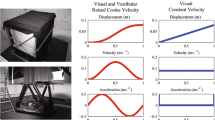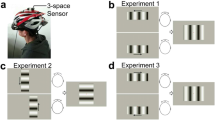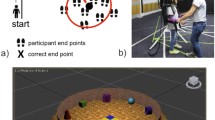Abstract
We recently published a study of the reconstruction of passively travelled trajectories from optic flow. Perception was prone to illusions in a number of conditions, and was not always veridical in the others. Part of the illusionary reconstructed trajectories could be explained by assuming that subjects base their reconstruction on the ego-motion percept built during the stimulus’ initial moments. In the current paper, we test this hypothesis using a novel paradigm: if the final reconstruction is governed by the initial percept, providing additional, extra-retinal information that modifies the initial percept should predictably alter the final reconstruction. The extra-retinal stimulus was tuned to supplement the information that was under-represented or ambiguous in the optic flow; the subjects were physically displaced or rotated at the onset of the visual stimulus. A highly asymmetric velocity profile (high acceleration, very low deceleration) was used. Subjects were required to guide an input device (in the form of a model vehicle; we measured position and orientation) along the perceived trajectory. We show for the first time that a vestibular stimulus of short duration can influence the perception of a much longer-lasting visual stimulus. Perception of the ego-motion translation component in the visual stimulus was improved by a linear physical displacement, perception of the ego-motion rotation component by a physical rotation. This led to a more veridical reconstruction in some conditions, but to a less veridical reconstruction in other conditions.







Similar content being viewed by others
Notes
This deceleration is not sub-threshold, but was the lowest smooth deceleration we could attain, and much weaker than the preceding acceleration.
This information and the vehicle’s representation were of course shown only during the response phases!
NB: we use Ψ to refer to rotation and Φ to refer to orientation. Thus, Φo represents the observer’s orientation at a given point, and Ψo the amount of change in this orientation (“yaw”) relative to the starting point.
References
Bakker NH, Werkhoven PJ, Passenier PO (1999) The effects of proprioceptive and visual feedback on geographical orientation in virtual environments. Presence 8:36–53
Berthoz A, Israël I, Georges-François P, Grasso R, Tsuzuku T (1995) Spatial memory of body linear displacement: What is being stored? Science 269:95–98
Bertin RJV, Israël I, Lappe M (2000) Perception of two-dimensional, simulated ego-motion trajectories from optic flow. Vision Res 40:2951–2971
Brandt T, Bartenstein P, Janek A, Dieterich M (1998) Reciprocal inhibitory visual-vestibular interaction. Visual motion stimulation deactivates the parieto-insular vestibular cortex. Brain 121(9): 1749–1758
Buizza A, Leger A, Droulez J, Berthoz A, Schmid R (1980) Influence of otolithic stimulation by horizontal linear acceleration on optokinetic nystagmus and visual motion perception. Exp Brain Res 39:165–176
Conditt MA, Gandolfo F, Mussa-Ivaldi FA (1997) The motor system does not learn the dynamics of the arm by rote memorization of past experience. J Neurophysiol 78:554–560
Crowell JA, Banks MS, Shenoy KV, Andersen RA (1998) Visual self-motion perception during head turns. Nat Neurosci 1:732–737
Ehrlich SM, Beck DM, Crowell JA, Freeman TC, Banks MS (1998) Depth information and perceived self-motion during simulated gaze rotations. Vision Res 38:3129–3145
Gibson JJ (1950) The perception of the visual world. Houghton Mifflin, Boston
Groen EL, Valenti Clari MSV, Hosman RJAW (2000) Psychophysical thresholds associated with the simulation of linear acceleration. AIAA 4294–4302
Harris LR, Jenkin M, Zikovitz DC (2000) Visual and non-visual cues in the perception of linear self motion. Exp Brain Res 135:12–21
Hlavacka F, Mergner T, Bolha B (1996) Human self-motion perception during translatory vestibular and proprioceptive stimulation. Neurosci Lett 210:83–86
Ivanenko YP, Grasso R, Israël I, Berthoz A (1997) The contribution of otoliths and semicircular canals to the perception of two-dimensional passive whole-body motion in humans. J Physiol (Lond) 502(1):223–233
Jürgens R, Boß T, Becker W (1999) Estimation of self-turning in the dark: comparison between active and passive rotation. Exp Brain Res 128:491–504
Kim NG, Turvey MT (1998) Visually perceiving heading on circular and elliptical paths. J Exp Psychol Hum Percept Perform 24:1690–1704
Koenderink JJ (1986) Optic flow. Vision Res 26:161–180
Lambrey S, Viaud-Delmon I, Berthoz A (2002) Influence of a sensorimotor conflict on the memorisation of a path travelled in virtual reality. Brain Res Cogn Brain Res 14(1):177–186
Lappe M, Bremmer F, van den Berg AV (1999) Perception of self-motion from visual flow [Review]. Trends in Cognitive Sciences 3:329–336
Li L, Warren WH Jr. (2000) Perception of heading during rotation: sufficiency of dense motion parallax and reference objects. Vision Res 40:3873–3894
Loose R, Ayan T, Probst T (1999) Visual motion direction evoked potentials are direction specifically influenced by concurrent vestibular stimulation. Clinical Neurophysiology 110:192–199
Mergner T, Becker W (1990) Perception of horizontal self-rotation: multisensory and cognitive aspects. In: Warren R, Wertheim AH (eds) Perception and control of self-motion. Lawrence Erlbaum, Hillsdale, pp 219–263
Mergner T, Schweigart G, Müller M, Hlavacka F, Becker W (2000) Visual contributions to human self-motion perception during horizontal body rotation. Arch Ital Biol 138:139–166
Mesland BS (1998) About horizontal self-motion perception. Dissertation, Utrecht University, the Netherlands
Pavard B, Berthoz A (1977) Linear acceleration modifies the perceived velocity of a moving visual scene. Perception 6:529–540
Probst T, Loose R, Niedeggen M, Wist ER (1995) Processing of visual motion direction in the fronto-parallel plane in the stationary or moving observer. Behav Brain Res 70:133–144
Probst T, Loose R, King SK, Stott JR, Wist ER, Wright R (1996) Perception of direction of visual motion. II. Influence of linear body acceleration. Behav Brain Res 81:147–154
Redlick FP, Jenkin M, Harris LR (2001) Humans can use optic flow to estimate distance of travel. Vision Res 41:213–219
Royden CS, Crowell JA, Banks MS (1994) Estimating heading during eye movements. Vision Res 34:3197–3214
Rushton SK, Harris JM, Lloyd MR, Wann JP (1998) Guidance of locomotion on foot uses perceived target location rather than optic flow. Curr Biol 8:1191–1194
Sibigtroth MP, Banks MS (2001) Vestibular stimulation in heading estimation. Presentation at VSS
von der Heyde M, Riecke BE, Cunningham DW, Bülthoff H (2001) Visual-vestibular sensor integration follows a Max-Rule: results from psychophysical experiments in Virtual Reality. Poster at the Tübinger Wahrnehmungskonferenz (TWK)
Wann JP, Schwapp DK (2000) Why you should look where you steer. Nat Neurosci 3:647–648
Wann JP, Swapp D, Rushton SK (2000) Heading perception and the allocation of attention. Vision Res 40:2533–2543
Wenzel R, Bartenstein P, Dieterich M, Danek A, Weindl A, Minoshima S, Ziegler S, Schwaiger M, Brandt T (1996) Deactivation of human visual cortex during involuntary ocular oscillations—A PET activation study. Brain 119:101–110
Acknowledgements
The authors wish to thank I. Israël, J. McIntyre and an anonymous reviewer for critically reading a previous version of this paper, and the many helpful, constructive comments that ensued. Michel Ehrette created the “vehicle”; France Maloumian most of Fig. 1.
Author information
Authors and Affiliations
Corresponding author
Rights and permissions
About this article
Cite this article
Bertin, R.J.V., Berthoz, A. Visuo-vestibular interaction in the reconstruction of travelled trajectories. Exp Brain Res 154, 11–21 (2004). https://doi.org/10.1007/s00221-003-1524-3
Received:
Accepted:
Published:
Issue Date:
DOI: https://doi.org/10.1007/s00221-003-1524-3




